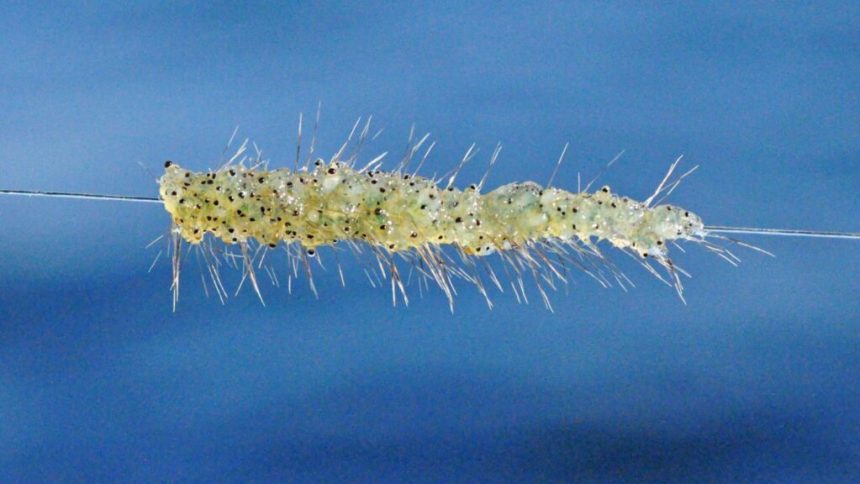Dozens of spiny water fleas are entangled on a fishing line. The animals, which are smaller than a fingernail and invasive in the Northeast, are often transported between water bodies on fishing tackle. (Photo by Emily DeBolt/New York Department of Environmental Conservation)
To track the arrival of invasive species in their beloved lake, the Newfound Lake Region Association monitors data from two sources: water samples, which they pull directly from the lake’s blue depths and preserve carefully in a refrigerator, and Facebook posts from observant anglers.
This September, the latter source turned up something the association had for years been hoping they wouldn’t see: a photograph of a tiny, free-floating crustacean whose smaller-than-a-fingernail body consists mostly of a long, delicate tail.
When Newfound Lake Region Association Conservation Program Manager Paul Pellissier first saw the photo, he confirmed the creature was a spiny water flea, an invasive species first spotted in New Hampshire two years ago. The discovery wasn’t exactly a surprise, but it was distressing: the spiny water flea is very hard to eliminate once it arrives in a water body, Pellissier said, and though it’s harmless to humans its presence can significantly upset a lake’s food chain and broader ecosystem.
In New Hampshire, the spiny water flea has not been present long enough to know just what that upset might look like for the state’s lakes. Newfound is only the third New Hampshire lake confirmed to host the creature, which was first spotted in lakes Winnipesaukee and Winnisquam in 2023. But lakes elsewhere in the country, including the Great Lakes, have been dealing with water flea invasions for decades, and scientists said findings from those systems could shine a light on what New Hampshire can expect from this new, hard-to-shake visitor.
Tiny invader, outsized impact
Spiny water fleas, native to Europe and Asia, likely arrived in the United States in contaminated ballast water that cargo ships released into the Great Lakes in the early 1980s, according to the Minnesota Department of Natural Resources. The creatures are small, but their long tails can entangle, allowing them to form masses that appear like black-spotted bits of jelly bristling with their namesake spines. They also frequently get caught on fishing tackle, which is thought to be a major way the animals are transferred from water body to water body, Pellissier said.
Since the 1980s, the creatures have become established in the Great Lakes as well as in other inland lakes, including Lake Champlain in Vermont. Their effects, said zooplankton expert Donn Branstrator, reverberate through the ecosystems they invade.
This is due to the fleas’ unique biology compared to native species, said Branstrator, who works as an associate professor of biology at the University of Minnesota Duluth. Branstrator began studying zooplankton in the Great Lakes as a graduate student in the late ’80s, when spiny water fleas had just begun to garner attention. Ever since, studying the animals — how they move between lakes, reproduce, and affect the ecosystems they infiltrate — has been a central part of his career.
One impact of a spiny water flea invasion stems from the animals’ voracious appetites. Upon arriving in a lake, spiny water fleas begin feeding on other tiny animals that live suspended in the water column, leading to population crashes. Lakes that Branstrator has examined saw their zooplankton populations cut in half, he said. These lakes also saw their zooplankton biodiversity — a measure of how many different types of the organisms are present in a system, which scientists often consider a key indicator of an ecosystem’s health — fall by about 20%, according to Branstrator.
This change has ripple effects that extend both up and down the food chain. Native zooplankton typically eat the tiny plants, algae, and photosynthetic bacteria, collectively known as phytoplankton, that also live free-floating lives in the water column. But when spiny water fleas eat most of those native zooplankton, the photosynthetic organisms at the base of the food chain have fewer predators — and in turn, they could run wild, Pellissier said.
“You’ll have greener, murkier lakes because of that,” he said.
A single spiny water flea is pictured atop a pencil eraser. The animals, though small, can have big impacts on the environments they invade, said zooplankton experts. They are currently known to be present in three New Hampshire lakes. (Photo by New Hampshire Department of Environmental Services)
Some research has also suggested that the changes caused by spiny water fleas could also include increases in cyanobacteria blooms, which New Hampshire has dealt with increasingly in recent years.
When spiny water fleas overrun native zooplankton, the effects also cascade up the food chain. Spiny water fleas are bigger than most native zooplankton, so they are less palatable to native fish, which find them difficult to eat. This is a problem, Pellissier said, because young fish mostly eat zooplankton before they are big enough to move on to larger meals.
While larger fish can swallow the fleas, they might still be harmed, too, Branstrator said. His team has observed tangled masses of water fleas inside fishes’ stomachs — and in some cases, they have seen evidence that the fleas’ spines punctured through the fishes’ stomach linings, he said.
When a water flea infestation takes hold, therefore, fewer fish may make it to adulthood, and those that do may be less hardy.
This effect has been demonstrated in the Great Lakes, Branstrator said, where recreationally and ecologically important species like walleye and yellow perch have become smaller and less abundant since water fleas’ arrival.
The changes spiny water fleas cause in native plankton populations, Branstrator said, happen fast; then, they stick around. In Minnesota, even in datasets that stretch over 10 years or more, he said, the shifts have remained mostly consistent.
“This happens within a couple years, then it’s maintained,” he said. “That is a pattern that has been repeated time and again throughout the Great Lakes and other inland lakes. … I would anticipate no difference in these lakes that you have out there.”
The Great Lakes are a different system from New Hampshire’s lakes, Branstrator said, and there are other factors at play in each system, such as the invasive zebra mussels that coexist with spiny water fleas in the Great Lakes and not, as of yet, in New Hampshire. However, he said, he expects many of the lessons learned from the invasion of spiny water fleas in the Great Lakes are still transferable to New Hampshire.
What can be done?
When it comes to removing spiny water fleas from a lake, scientists have explored plenty of ideas, Branstrator said. But, he continued, “nobody has figured out how to eradicate them.”
Lack of success treating the infestations, though, has not been for a lack of ideas. Branstrator said past proposals have included controlling the animals with predatory fish, like the pumpkinseed sunfish, which with its tough snail-crushing teeth is one of the few native fish species well-adapted to consuming spiny water fleas. But pumpkinseed sunfish prefer shallow waters, while water fleas tend to prefer deep, cold areas, Branstrator said. And, he added, to begin with, “it’d be kind of absurd to think you could add that many fish to a system” to handle a booming water flea population.
Some other aquatic invasive species, like zebra mussels, are treated with toxic chemicals (though with mixed results). But, according to Branstrator, water fleas disperse so quickly and broadly throughout a lake that the area in need of treatment would be prohibitively large for that technique.
“All of a sudden, you’ve got millions. Their life cycle is short, and they reproduce fast, and, you know, trying to stop exponential growth is a difficult thing to do,” he said.
Preventing further spread and looking ahead
When it comes to handling a spiny water flea infestation, like what the Newfound Lake Region Association is anticipating they will now have on their hands, Pellissier said he expects to focus on managing the fleas’ impacts and preventing further spread.
“Once we have it, we have it, so it becomes more a question of, can you manage the impacts?” he said.
While the effects on fish populations are difficult to address, the effects of spiny water fleas on phytoplankton can be kept in check, Branstrator and Pellissier said, by limiting the amount of nutrients that are allowed to flow into a lake. This means preventing fertilizer runoff and stormwater runoff and mitigating erosion, Pellissier said.
“If algae is nutrient limited to begin with, it doesn’t matter if you take the brakes off of grazing or not. They’re not going to grow,” Branstrator said.
It will also be important to continue monitoring New Hampshire’s lakes and for everyone — especially anglers — to do what they can to prevent the spread of these animals and protect fish, Pellissier said.
Branstrator’s research has indicated that humans transfer water fleas between water bodies, often on fishing tackle. He has also proven that extended exposure to dry air is enough to kill spiny water fleas, with about 1½ hours of drying time killing the fleas’ adult forms and four to six hours enough to kill their eggs, according to his work. But when the fleas are tangled together or clinging to damp gear, they may take longer to dry, and to die, Branstrator cautioned.
When there isn’t time to let things dry, cleaning boats, fishing gear, and anything else that’s been immersed in lake water thoroughly with hot water or a mild bleach solution is another good way to prevent the spread of spiny water fleas, Pellissier said.
Branstrator added that everyone has the potential to make a difference by cleaning or drying their gear and boat properly, because it likely takes multiple “seeding” events for the water fleas to establish in a lake or other water body.
Pellissier said he hopes those who spend time on New Hampshire waterways will take spiny water fleas seriously and do what they can to prevent further spread.
“My concern is that this thing is so small, and nearly invisible, that people won’t give it the respect or attention that it deserves,” he said.
He also hopes the water samples that the Newfound Lake Region Association has been collecting will help form the basis for a long-term understanding of how the creature affects New Hampshire waters. The association is working with the Department of Environmental Services and the University of New Hampshire to track that data, he said.
“That, I think, is going to be really important baseline data to understand the impacts of spiny water flea on Newfound, and potentially understand what the impacts might be on other lakes across the state,” he said. “… We can actually see that impact play out on Newfound.”








